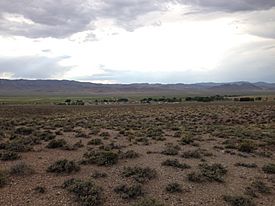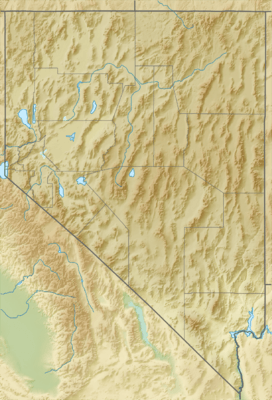Duckwater Valley facts for kids
Quick facts for kids Duckwater Valley |
|
|---|---|

The valley with the village Duckwater and the Pancake Range in the background.
|
|
| Floor elevation | 5,495 feet (1,675 m) |
| Length | 12 miles (19 km) North-south |
| Geography | |
| Population centers | Duckwater |
| Borders on | Pancake Range (west) and Duckwater Hills (east) |
| Traversed by | Duckwater Creek |
| GNIS ID: 840205 | |
Duckwater Valley is a beautiful valley located in Nye County, Nevada. It stretches about 12 miles (19 km) from north to south. This valley is surrounded by mountains. To the west, you'll find the Pancake Range. To the east, there are the Duckwater Hills.
A stream called Duckwater Creek flows through the valley. Part of State Route 379 also runs through this area. The only town in the valley is Duckwater. A large part of the valley is home to the Duckwater Reservation.
Contents
History of Duckwater Valley
The Duckwater Valley has a long and interesting past. For many years, Native Americans lived here. They were the first people to call this valley home.
Early Settlers and Farming
In the 1860s, things began to change. Silver ore was found near a place called Hamilton. This discovery brought the first white American settlers to Duckwater Valley. They started farms to grow food for the people in Hamilton.
Farmers grew hay, grain, vegetables, and fruit. One of the first settlers was Isaak "Ike" Irwin. In 1868, he settled in what is now the village of Duckwater. He was known for growing hay.
When Hamilton started to decline, farmers in Duckwater Valley changed their focus. They grew hay and grain mainly to feed their cattle. An old book from 1881, History of Nevada, said the valley was mostly meadows. About 800 acres (320 ha) were used for farming. This land produced grain and vegetables. Some fruit plants had also just been planted.
Growth of Livestock Farming
Over time, raising livestock became very important in Duckwater Valley. It grew to be the biggest industry there. Around 1910, farmers had to reduce the number of their cattle. This was because wild sheep flocks were damaging their rangelands during winter.
In 1913, a newspaper called the Ely Record wrote about the valley. It said Duckwater Valley was "one of the most extensive ranching and farming sections in Eastern Nevada." The newspaper mentioned several large ranches. One ranch had 1,000 acres (400 ha) of land. About 600 acres (240 ha) of that land was used for growing crops. These ranches grew hay, grain, alfalfa, and potatoes. They also had many herds of cattle.
The Duckwater Shoshone Reservation
The Duckwater Shoshone Tribe has a reservation located entirely within the Duckwater Valley. This reservation covers more than 3,850 acres (1,560 ha). It was officially created in 1940.
The idea for a reservation first came up in 1937. Workers from the Florio Ranch suggested it. The ranch owner could not pay for his land after losing all his sheep in a big snowstorm. The workers thought they could sell the ranch, along with other ranches, to the government. This land would then become an Indian reservation.
The Shoshone people supported this idea. So, the Bureau of Indian Affairs bought two ranches. This is how the Indian reservation was created. When it first started, it was 3,240 acres (1,310 ha) in size. Since then, the government has bought more ranch lands to make the reservation bigger.


